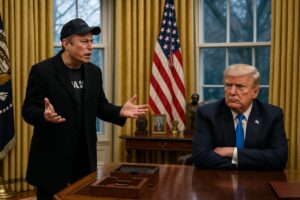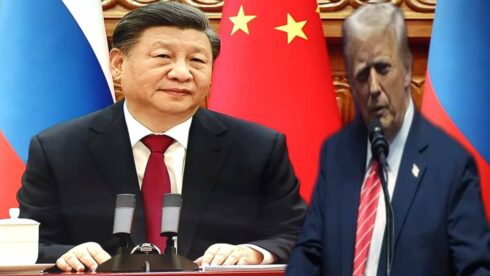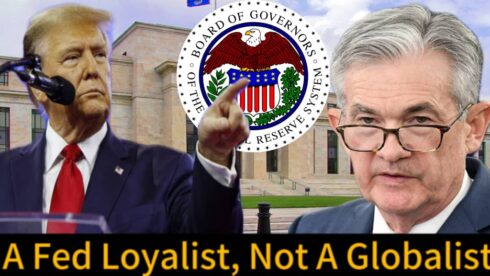China has decided to impose a 15% tariff on U.S. coal and liquefied natural gas (LNG), effective from February 10, 2025. This significant escalation in the ongoing trade war is seen as a direct retaliation to the U.S.’s own 10% tariffs on a wide range of Chinese imports. The Chinese Ministry of Finance’s announcement outlines these countermeasures, also targeting U.S. crude oil, agricultural machinery, and vehicles with a 10% tariff. This reciprocal action underscores the increasing tensions between the two economic superpowers.
The imposition of these tariffs is part of a broader strategy by China to assert its stance in the trade war with the U.S. Following the Trump administration’s initial tariff imposition, Beijing wasted no time in announcing retaliatory measures. China Commerce Ministry argues that these U.S. tariffs violate World Trade Organization rules, accusing Washington of undermining the global economic order and disrupting essential trade relations. This latest move could drastically affect U.S. exports, especially coal and LNG, both of which have been staples of American trade with China for years.
U.S. Tariff Policy Under President Trump: A Catalyst for Global Tensions
President Trump’s aggressive tariff policies have been a defining feature of his economic strategy throughout his second term, especially in dealing with China. The rationale behind these tariffs was to level the playing field, particularly targeting intellectual property theft, technology transfers, and trade imbalances. However, despite claims that tariffs would primarily burden foreign exporters, the ripple effects of this policy have caused considerable concern among domestic consumers and industries. The trade conflict with China has exacerbated global economic uncertainty, contributing to volatility in both domestic and international markets.
The Trump administration’s strategy was built on the assumption that China would bear the brunt of these tariffs, but analysts argue that the reality is far more complex. U.S. consumers and businesses have also felt the sting of these measures, with price increases on goods ranging from electronics to agricultural products. Furthermore, industries like manufacturing and tech, which rely on Chinese imports, have been forced to reassess their supply chains. The U.S.-China trade war has thus become a far-reaching economic and geopolitical issue, with both nations facing significant domestic and international repercussions.
China’s Countermeasures and Their Impact on U.S. Exports
China’s decision to impose a 15% tariff on U.S. coal and LNG signals a major shift in the global energy market. The U.S. has been a dominant supplier of coal and LNG to China, with significant volumes of both commodities being exported in recent years. However, the escalating trade tensions have put these exports at risk. The imposition of tariffs could lead to a sharp decline in U.S. energy exports to China, forcing American producers to look for alternative markets, potentially at lower prices.
In addition to coal and LNG, China has also targeted U.S. crude oil, agricultural machinery, and vehicles, further straining the trade relationship between the two countries. The agricultural sector, in particular, could be hit hard by these tariffs, as China has been a major buyer of U.S. soybeans and other crops. These tariffs will likely result in significant shifts in global trade flows, as both China and the U.S. explore new markets to mitigate the impact of the tariffs. The broader economic fallout could include job losses, decreased production, and slower economic growth in both countries.
The Role of the World Trade Organization (WTO) in the Conflict
The U.S. and China have both accused each other of violating World Trade Organization (WTO) rules, adding another layer of complexity to the trade conflict. China has consistently argued that U.S. tariffs violate international trade agreements, particularly those that govern the fair treatment of foreign businesses and the prevention of trade barriers. On the other hand, the U.S. has maintained that China’s trade practices—ranging from intellectual property theft to state-backed industrial policies—are unfair and harmful to American businesses.
The WTO has become an increasingly important player in this ongoing dispute, with both sides seeking to utilize its mechanisms to either justify their actions or challenge the other’s policies. However, the organization has been criticized for its inability to effectively address the rapidly evolving nature of modern trade, particularly when it comes to complex issues like technology transfers and intellectual property rights. As the U.S. and China continue to escalate their tariffs, the WTO’s role in resolving this dispute remains uncertain, with both countries likely to pursue unilateral actions rather than relying on multilateral negotiation.
Mixed Market Reactions and the Future of Global Trade
Following China’s announcement of new tariffs, global markets reacted with uncertainty and caution. While there was initial optimism after the U.S. reached a temporary tariff pause with Canada and Mexico, China’s swift response has dampened hopes for a quick resolution to the trade war. Stock markets worldwide saw a recalibration of expectations, as investors began to adjust to the reality that the U.S.-China trade conflict is unlikely to be resolved anytime soon.
Public sentiment, reflected in social media posts on platforms like X, has been a mixture of concern and confusion. Many users have expressed doubts about the potential economic repercussions, particularly in sectors heavily reliant on international trade. However, it is important to remember that these online discussions represent opinions rather than verified economic data. In the coming months, as both countries adjust to the new tariff landscape, the full economic impact of these actions will become clearer, though it is expected that both China and the U.S. will continue to navigate the complexities of this ongoing trade war.
The Long-Term Geopolitical Implications of U.S.-China Tariffs
Beyond the immediate economic consequences, the tariffs imposed by both the U.S. and China are reshaping the global geopolitical landscape. As both nations continue to engage in this high-stakes trade war, their actions are influencing global supply chains, investment strategies, and diplomatic relations. Countries around the world are closely watching the unfolding dispute, as it could have far-reaching effects on global trade dynamics, international alliances, and power structures.
One of the most significant implications of the U.S.-China trade war is the shifting balance of power in the Asia-Pacific region. As China strengthens its economic ties with countries like Russia and Japan, the U.S. is looking to bolster its alliances with nations in the Indo-Pacific. This ongoing trade conflict is not just an economic issue; it is a geopolitical struggle for influence, with both the U.S. and China seeking to assert their dominance on the world stage. As the trade war continues to evolve, its geopolitical ramifications will undoubtedly have lasting effects on the global order for years to come.














